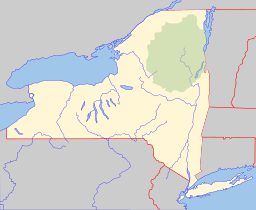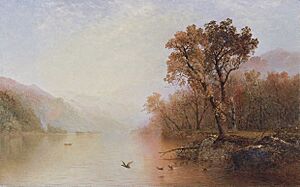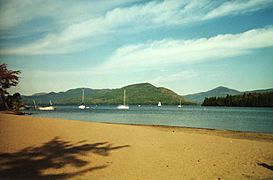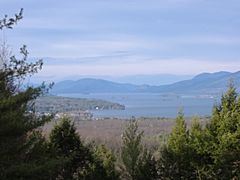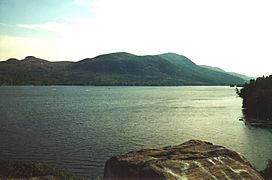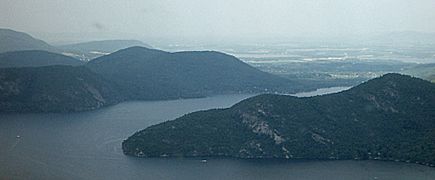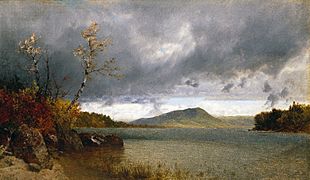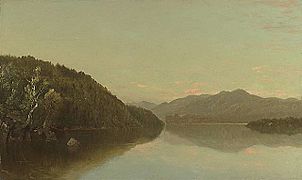Lake George (New York) facts for kids
Quick facts for kids Lake George |
|
|---|---|
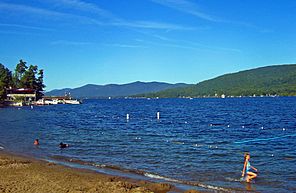
Lake George from the village of Lake George at the southern end.
|
|
| Location | Adirondack Mountains, Warren / Essex counties, New York, United States |
| Coordinates | 43°37′20″N 73°32′48″W / 43.62222°N 73.54667°W |
| Primary inflows | Streams 55%, Precipitation on lake surface 27%, groundwater 18% |
| Primary outflows | La Chute River |
| Basin countries | United States |
| Max. length | 32.2 mi (51.8 km) |
| Max. width | 2 mi (3.2 km) |
| Surface area | 45 sq mi (120 km2) |
| Average depth | 70 ft (21 m) |
| Max. depth | 196 ft (60 m) |
| Water volume | .597 cu mi (2.49 km3) |
| Surface elevation | 320 ft (98 m) |
| Islands | Over 170 (172-178) |
| Settlements | Lake George, Ticonderoga, Bolton Landing, Huletts Landing |
Lake George, also known as the Queen of American Lakes, is a long, narrow lake in the Adirondack Mountains of New York. It's a very clean lake, which scientists call an "oligotrophic lake."
The lake flows north into Lake Champlain and then into the St. Lawrence River. This path has been important for travel and trade for a long time. It connects Albany, New York, to Montreal, Quebec, Canada.
Lake George is about 32 miles (52 km) long and up to 196 feet (60 meters) deep. It is between 1 and 3 miles (1.6 to 4.8 km) wide. This makes it a big natural barrier for travel from east to west. While not many people live around the lake all year, its population grows to over 50,000 in the summer. Many visitors stay in the village of Lake George at the southern end.
The lake's water flows into Lake Champlain through the La Chute River. This river has many waterfalls and rapids. It drops 226 feet (69 meters) over its 3.5-mile (5.6 km) course. Most of the river is in Ticonderoga, New York, near Fort Ticonderoga. Eventually, these waters reach the Atlantic Ocean.
Contents
Exploring Lake George's Geography
Lake George is located in the southeastern part of the Adirondack State Park. It is part of the St. Lawrence watershed, which means its waters eventually flow into the St. Lawrence River.
Famous Natural Spots
The area around Lake George has many interesting landforms. Some well-known spots include Anthony's Nose, Deer's Leap, and Peggy's Point. You can also find the Indian Kettles and Roger's Rock.
Mountains and Bays Around the Lake
Several mountains surround Lake George. These include Black Mountain, Elephant Mountain, and Prospect Mountain. Other mountains are Shelving Rock, Sleeping Beauty Mountain, and the Tongue Mountain Range. The lake also has famous bays like Basin Bay, Kattskill Bay, and Northwest Bay.
Islands of Lake George
A special part of the lake is "The Narrows." This section is about 5 miles (8 km) long and filled with islands. It's bordered by the Tongue Mountain Range on one side and Black Mountain on the other. Lake George has over 170 islands in total. Most of these, about 148, are owned by the state. The islands vary in size, from tiny ones like Skipper's Jib to larger ones like Vicar's and Long Islands. You can even get permits to camp on many of them.
Deepest Point and Connections
The deepest part of Lake George is 196 feet (60 meters) deep. This spot is between Dome Island and Buck Mountain. The northern end of the lake, near Ticonderoga, is considered the southern end of the Champlain Valley. This valley includes Lake Champlain and cities like Plattsburgh and Burlington, Vermont.
The Smartest Lake Project
Since 2014, a special project called The Jefferson Project has been studying Lake George. IBM, Rensselaer Polytechnic Institute, and the Fund for Lake George work together on it. They use sensors to collect data about the lake's currents, pH levels, and other important information. Because of this, Lake George is sometimes called "the smartest lake in the world."
Protecting Lake George from Invasive Species
An invasive species is a plant or animal that is not native to an area and can cause harm to the environment. Lake George has six known invasive species.
The biggest threat to the lake is the Asian clam, which was first found in 2010. The Eurasian watermilfoil is another major concern. Other invasive species found in Lake George include the Chinese mystery snail, curly-leaf pondweed, spiny water flea, and zebra mussel. Efforts are made to control these species to protect the lake's natural environment.
A Look Back at Lake George's History
Lake George has a rich history, playing a key role in early American events.
Early Names and Explorers
Native Americans originally called the lake Andia-ta-roc-te. Later, in his famous book The Last of the Mohicans, James Fenimore Cooper called it the Horican. He thought the original name was too hard to say.
The first European to see the lake was a French missionary named Isaac Jogues in 1646. He named it Lac du Saint-Sacrement, which means "Lake of the Holy Sacrament." He also named its outflowing stream La Chute, meaning "The Fall."
French and Indian War Era
In 1755, during the French and Indian War, British forces led by William Johnson took control of the area. Johnson renamed the lake Lake George, in honor of King George II.
A major battle, the Battle of Lake George, took place here on September 8, 1755. The British and their Iroquois allies won a key victory against the French. After this, Johnson ordered the building of Fort William Henry at the lake's southern end. This fort was named after the King's grandson, Prince William Henry.
The French built Fort Ticonderoga where the La Chute River enters Lake Champlain. These forts were very important because they controlled the easy water route between Canada and colonial New York. In 1757, a French army led by General Louis-Joseph de Montcalm attacked Fort William Henry. After the British surrendered, the fort was burned down. During their retreat, British soldiers were attacked by Native Americans allied with the French. This event became known as The Massacre at Fort William Henry.
In 1758, a daring attack on Fort Ticonderoga was led by Robert Rogers and his group, Rogers' Rangers. Their unique fighting methods later inspired the creation of special forces like the United States Army Rangers.
Lake George in the American Revolution
Lake George's location was also very important during the American Revolution. Control of the forts at both ends of the lake, especially Ticonderoga, was crucial.
Later in the war, British General John Burgoyne made a decision that led to a major British defeat. He chose not to use the easy water route of Lake George to reach the Hudson River. Instead, he tried to go through the difficult marshes and forests at the southern end of Lake Champlain. This decision contributed to the British loss at Saratoga.
Lake George Inspires Artists
On May 31, 1791, Thomas Jefferson wrote a letter describing Lake George. He called it "the most beautiful water I ever saw." He admired its clear water, the mountains forming a basin, and the rich groves of trees along the shore.
In the late 1800s and early 1900s, many famous artists came to Lake George for inspiration. These included Martin Johnson Heade, John F. Kensett, and Georgia O'Keeffe.
Lake George as a Tourist Destination
Lake George has been a popular vacation spot for a long time.
Early Tourism and Grand Hotels
In the late 1800s and early 1900s, Lake George became a favorite place for wealthy and famous people. It was easy to reach by train from New York City and Montreal. Families like the Roosevelts, Vanderbilts, and Rockefellers visited its shores.
Grand hotels like the Fort William Henry Hotel and The Sagamore opened to welcome tourists. The richest visitors often stayed in their own large private homes.
Summer Camps and Activities
The Silver Bay YMCA on Lake George was built in 1900. It is now a summer family camp that hosts many organizations and tourists. Since 1913, YMCA Camp Chingachgook, on the East Shore, has also welcomed thousands of guests each summer.
Today, Lake George is still a popular place for vacations. People enjoy water sports, camping, amusement parks, hiking, and shopping. Every September, one of the oldest hot air balloon gatherings happens nearby in Queensbury.
Millionaires' Row: Grand Summer Homes
"Millionaires' Row" was the nickname for a part of Lake Shore Drive on the west side of the lake. Here, wealthy people built huge summer homes, which they sometimes called "cottages." These houses were very large, often with dozens of bedrooms and over 20,000 square feet (1,858 square meters) of space.
Unlike the rustic log cabins built by other rich people in the Adirondacks, these homes were made of stone and brick. They were built in grand styles like Tudor Revival and Italianate. These mansions were often set on hundreds of acres of beautiful lakeside land.
Over time, with changes in the economy, these huge mansions became harder to maintain. By the 1950s, more people could afford to travel by car and plane. Lake George became popular with the middle class, and many of the mansions were torn down or turned into hotels and restaurants. Some of these grand homes still exist today, like Evelley, Halcyon, and Sun Castle.
Images for kids
Photographs
-
View from The Sagamore in Bolton Landing
-
An aerial view of Lake George, with Anthony's Nose and Roger's Rock visible
Paintings
-
John Frederick Kensett - Lake George - Brooklyn Museum
-
John William Casilear - - Lake George - Brooklyn Museum
-
Régis François Gignoux - Lake George - Brooklyn Museum
Videos


